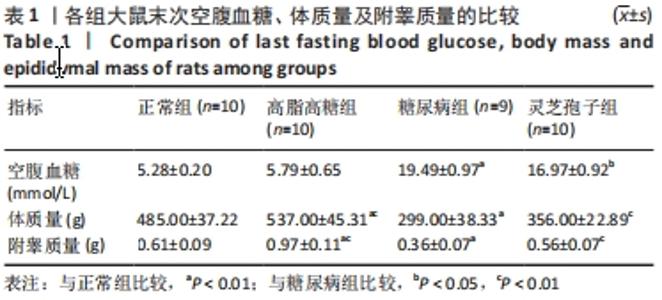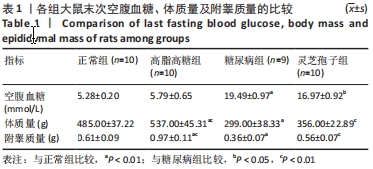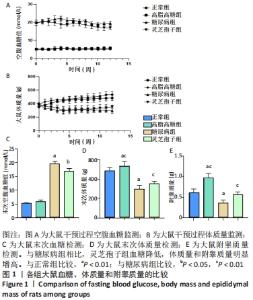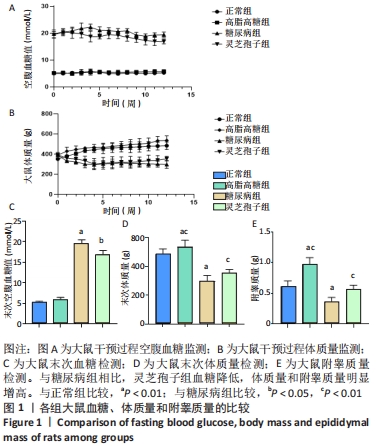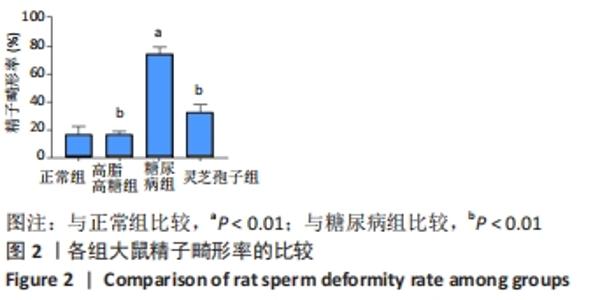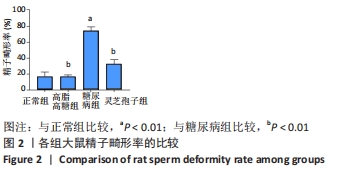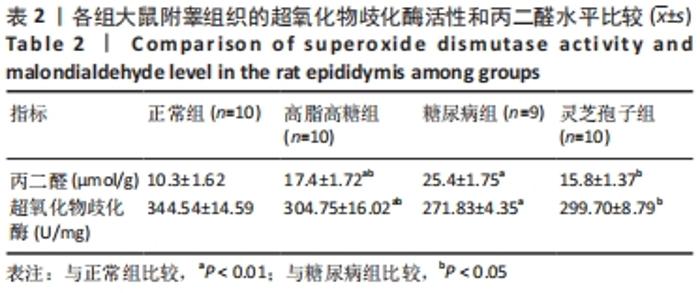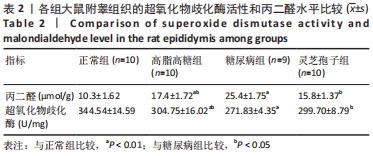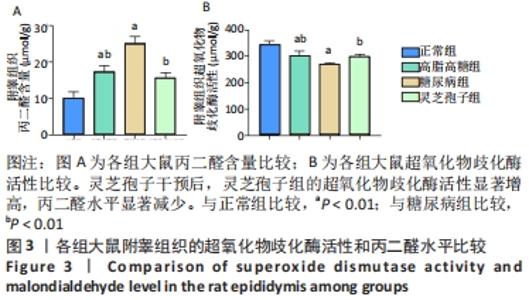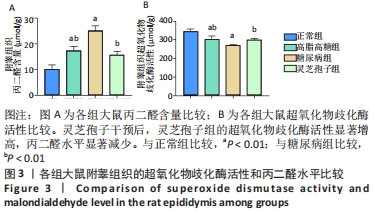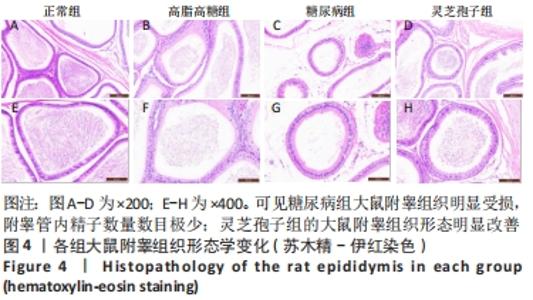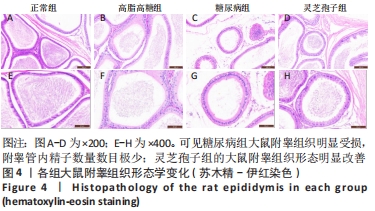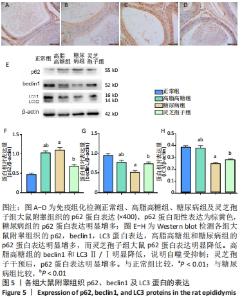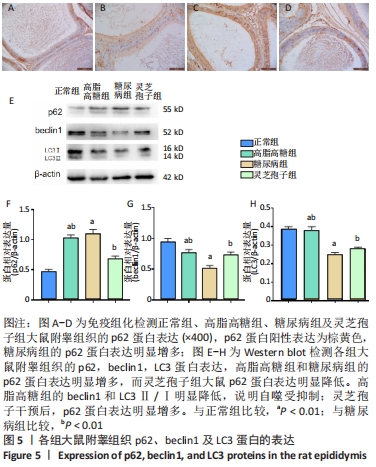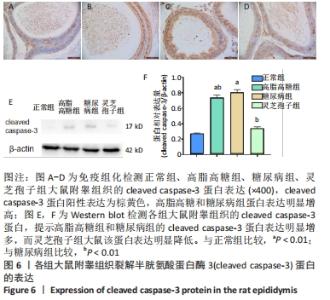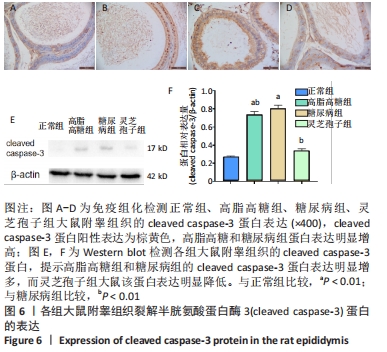Chinese Journal of Tissue Engineering Research ›› 2022, Vol. 26 ›› Issue (29): 4632-4637.doi: 10.12307/2022.851
Previous Articles Next Articles
Protective effect of Ganoderma lucidum spores on epididymis and authophage in diabetic rats
Zhang Xin, Ma Xiaoru, Xue Jingwen, Wang Fangfang, Wu Lan, Li Yue
- School of Basic Medicine, Jiamusi University, Jiamusi 154007, Heilongjiang Province, China
-
Received:2021-09-17Accepted:2021-10-31Online:2022-10-18Published:2022-03-28 -
Contact:Ma Xiaoru, Master, Professor, School of Basic Medicine, Jiamusi University, Jiamusi 154007, Heilongjiang Province, China -
About author:Zhang Xin, Master, School of Basic Medicine, Jiamusi University, Jiamusi 154007, Heilongjiang Province, China
CLC Number:
Cite this article
Zhang Xin, Ma Xiaoru, Xue Jingwen, Wang Fangfang, Wu Lan, Li Yue. Protective effect of Ganoderma lucidum spores on epididymis and authophage in diabetic rats[J]. Chinese Journal of Tissue Engineering Research, 2022, 26(29): 4632-4637.
share this article
Add to citation manager EndNote|Reference Manager|ProCite|BibTeX|RefWorks
| [1] HE Z, YIN G, LI QQ, et al. Diabetes Mellitus Causes Male Reproductive Dysfunction: A Review of the Evidence and Mechanisms. In Vivo. 2021; 35(5):2503-2511. [2] LI Z, SHI Y, ZHANG X, et al. Screening immunoactive compounds of Ganoderma lucidum spores by mass spectrometry molecular networking combined with in vivo zebrafish assays. Front Pharmacol. 2020;11:287. [3] HYLMAROVA S, STECHOVA K, PAVLINKOVA G, et al. The impact of type 1 diabetes mellitus on male sexual functions and sex hormone levels. Endocr J. 2020;67(1):59-71. [4] MARESCH CC, STUTE DC, ALVES MG, et al. Diabetes-induced hyperglycemia impairs male reproductive function: a systematic review. Hum Reprod Update. 2018;24(1):86-105. [5] BOERI L, VENTIMIGLIA E, CAZZANIGA W, et al. Risk of health status worsening in primary infertile men: A prospective 10-year follow-up study. Andrology. 2021. doi: 10.1111/andr.13090. [6] KOREJO NA, WEI QW, SHAH AH, et al. Effects of concomitant diabetes mellitus and hyperthyroidism on testicular and epididymal histoarchitecture and steroidogenesis in male animals. J Zhejiang Univ Sci B. 2016;17(11):850-863. [7] CORRÊA LB NS, DA COSTA CAS, RIBAS JAS, et al. Antioxidant action of alpha lipoic acid on the testis and epididymis of diabetic rats: morphological, sperm and immunohistochemical evaluation. Int Braz J Urol. 2019;45(4):815-824. [8] PEREIRA SC, OLIVEIRA PF, OLIVEIRA SR, et al. Impact of Environmental and Lifestyle Use of Chromium on Male Fertility: Focus on Antioxidant Activity and Oxidative Stress. Antioxidants (Basel). 2021; 10(9):1365. [9] LIU L, WANG X, LIU K, et al. Inhibition of inducible nitric oxide synthase improved erectile dysfunction in rats with type 1 diabetes. Andrologia. 2021;53(8):e14138. [10] BARKABI-ZANJANI S, GHORBANZADEH V, ASLANI M, et al. Diabetes mellitus and the impairment of male reproductive function: Possible signaling pathways. Diabetes Metab Syndr. 2020;14(5):1307-1314. [11] 王东春,肖红,舒琴,等.百令胶囊联合辛伐他汀对2型糖尿病肾病患者氧化与抗氧化失衡及炎性介质水平的影响[J].解放军医药杂志,2020,32(9):39-43. [12] 张卫华,陈东.叶黄素通过激活Nrf2信号传导通路抑制糖尿病性骨质疏松模型大鼠氧化应激及炎性反应的机制研究[J].临床误诊误治,2020,33(7):99-103. [13] 杨帆,白抚生,尤林,等.依达拉奉对脑缺血再灌注损伤患者神经功能、氧化应激和炎性反应的影响[J].疑难病杂志,2020,19(9): 880-883+887. [14] 邓宇飞,翁治委,梁爱军,等.参精固本丸对大鼠睾丸氧化应激损伤后生精功能的修复[J].中华男科学杂志,2019,25(12):1118-1125. [15] LI D, DING Z, DU K, et al. Reactive Oxygen Species as a Link between Antioxidant Pathways and Autophagy. Oxid Med Cell Longev. 2021; 2021:5583215. [16] KITADA M, KOYA D. Autophagy in metabolic disease and ageing. Nat Rev Endocrinol. 2021;17(11):647-661. [17] YUN HR, JO YH, KIM J, et al. Roles of Autophagy in Oxidative Stress.Int J Mol Sci. 2020;21(9):3289. [18] LI J, LIN FH, ZHU XM, et al. Impact of diabetic hyperglycaemia and insulin therapy on autophagy and impairment in rat epididymis. Andrologia. 2020;52(11):e13889. [19] WU H, WU S, ZHU Y, et al. Aspirin restores endothelial function by mitigating 17β-estradiol-induced α-SMA accumulation and autophagy inhibition via Vps15 scaffold regulation of Beclin-1 phosphorylation. Life Sci. 2020;259:118383. [20] 肖博雅,董理鑫,高慧,等.褪黑素可改善PBDE-47所致PC12细胞的异常自噬与凋亡[J].南方医科大学学报,2021,41(9):1409-1414. [21] PEI C, WANG F, HUANG D, et al. Astragaloside IV Protects from PM2.5-Induced Lung Injury by Regulating Autophagy via Inhibition of PI3K/Akt/mTOR Signaling in vivo and in vitro. J Inflamm Res. 2021;14:4707-4721. [22] SÁNCHEZ-MARTÍN P, SAITO T, KOMATSU M. p62/SQSTM1: ‘Jack of all trades’ in health and cancer. FEBS J. 2019;286(1):8-23. [23] DENG Z, LIM J, WANG Q, et al. ALS-FTLD-linked mutations of SQSTM1/p62 disrupt selective autophagy and NFE2L2/NRF2 anti-oxidative stress pathway. Autophagy. 2020;16(5):917-931. [24] SHIN WH, PARK JH, CHUNG KC. The central regulator p62 between ubiquitin proteasome system and autophagy and its role in the mitophagy and Parkinson’s disease. BMB Rep. 2020;53(1):56-63. [25] KO JH, YOON SO, LEE HJ, et al. Rapamycin regulates macrophage activation by inhibiting NLRP3 inflammasome-p38 MAPK-NFkappaB pathways in autophagy- and p62-dependent manners. Oncotarget. 2017;8(25):40817-40831. [26] ZHANG H, ZHANG Y, ZHU X, et al. DEAD Box Protein 5 Inhibits Liver Tumorigenesis by Stimulating Autophagy via Interaction with p62/SQSTM1. Hepatology. 2019;69(3):1046-1063. [27] MARENINOVA OA, JIA W, GRETLER SR, et al. Transgenic expression of GFP-LC3 perturbs autophagy in exocrine pancreas and acute pancreatitis responses in mice. Autophagy. 2020;16(11):2084-2097. [28] PUGSLEY HR. Assessing Autophagic Flux by Measuring LC3, p62, and LAMP1 Co-localization Using Multispectral Imaging Flow Cytometry. J Vis Exp. 2017;(125):55637. [29] LIU WJ, YE L, HUANG WF, et al. p62 links the autophagy pathway and the ubiqutin-proteasome system upon ubiquitinated protein degradation. Cell Mol Biol Lett. 2016;21:29. [30] JEONG SJ, ZHANG X, RODRIGUEZ-VELEZ A, et al. p62/SQSTM1 and Selective Autophagy in Cardiometabolic Diseases. Antioxid Redox Signal. 2019;31(6):458-471. [31] BARTOLINI D, DALLAGLIO K, TORQUATO P, et al. Nrf2-p62 autophagy pathway and its response to oxidative stress in hepatocellular carcinoma. Transl Res. 2018;193:54-71. [32] LIU H, DAI C, FAN Y, et al. From autophagy to mitophagy: the roles of P62 in neurodegenerative diseases. J Bioenerg Biomembr. 2017; 49(5):413-422. |
| [1] | LIU Danni, SUN Guanghua, ZHOU Guijuan, LIU Hongya, ZHOU Jun, TAN Jinqu, HUANG Xiarong, PENG Ting, FENG Wei-bin, LUO Fu. Effect of electroacupuncture on apoptosis of neurons in cerebral cortex of rats with cerebral ischemia-reperfusion injury at "Shuigou" and "Baihui" points [J]. Chinese Journal of Tissue Engineering Research, 2022, 26(在线): 1-6. |
| [2] | Gao Lei, Qin Xinyuan, Nie Xin, Wang Lei, Wang Jiangning. Extracorporeal circulation compression perfusion in the reconstruction of limb microcirculation from the mechanism of mechanical and chemical signal transduction [J]. Chinese Journal of Tissue Engineering Research, 2022, 26(9): 1334-1340. |
| [3] | Lü Yiyan, Li Hanbing, Ma Xiaoqing, Zhang Han, Zhang Yuhang, Li Genlin. Establishment and characteristic analysis of interior heat and diabetes mouse model using compound factors [J]. Chinese Journal of Tissue Engineering Research, 2022, 26(8): 1187-1193. |
| [4] | Chen Xianghe, Liu Bo, Yang Kang, Lu Pengcheng, Yu Huilin. Treadmill exercise improves the myocardial fibrosis of spontaneous type 2 diabetic mice: an exploration on the functional pathway [J]. Chinese Journal of Tissue Engineering Research, 2022, 26(8): 1210-1215. |
| [5] | Wen Dandan, Li Qiang, Shen Caiqi, Ji Zhe, Jin Peisheng. Nocardia rubra cell wall skeleton for extemal use improves the viability of adipogenic mesenchymal stem cells and promotes diabetes wound repair [J]. Chinese Journal of Tissue Engineering Research, 2022, 26(7): 1038-1044. |
| [6] | Cui Xing, Sun Xiaoqi, Zheng Wei, Ma Dexin. Huangqin Decoction regulates autophagy to intervene with intestinal acute graft-versus-host disease in mice [J]. Chinese Journal of Tissue Engineering Research, 2022, 26(7): 1057-1062. |
| [7] | Zhang Yujie, Yang Jiandong, Cai Jun, Zhu Shoulei, Tian Yuan. Mechanism by which allicin inhibits proliferation and promotes apoptosis of rat vascular endothelial cells [J]. Chinese Journal of Tissue Engineering Research, 2022, 26(7): 1080-1084. |
| [8] | Shui Xiaoping, Li Chunying, Li Shunchang, Sun Junzhi, Su Quansheng . Effects of aerobic and resistance exercises on brain-derived neurotrophic factor, nuclear factor-kappa B and inflammatory cytokines in skeletal muscle of type II diabetic rats [J]. Chinese Journal of Tissue Engineering Research, 2022, 26(5): 669-675. |
| [9] | Deng Shuang, Pu Rui, Chen Ziyang, Zhang Jianchao, Yuan Lingyan . Effects of exercise preconditioning on myocardial protection and apoptosis in a mouse model of myocardial remodeling due to early stress overload [J]. Chinese Journal of Tissue Engineering Research, 2022, 26(5): 717-723. |
| [10] | Song Jianzhi, Xu Lisen, Zhang Chen, Tu Feng, Niu Fei. Mechanism by which SC79, an Akt activator, inhibits dexamethasone-induced apoptosis and programmed necrosis of osteoblasts [J]. Chinese Journal of Tissue Engineering Research, 2022, 26(29): 4699-4703. |
| [11] | Du Shasha, Cai Zhiguo, Yang Kun, Liu Qi. Pancreatic autophagy and protein expression of insulin-related genes in type 2 diabetic rats with periodontitis [J]. Chinese Journal of Tissue Engineering Research, 2022, 26(29): 4605-4610. |
| [12] | Fu Yu, Shang Huayu, Li Shunchang. Aerobic and resistance exercises can alleviate liver inflammation in type 2 diabetic rats [J]. Chinese Journal of Tissue Engineering Research, 2022, 26(29): 4666-4671. |
| [13] | Yang Wei, Han Qingmin. Exploring peripheral blood biomarkers and therapeutic drugs for osteoarthritis based on bioinformatics [J]. Chinese Journal of Tissue Engineering Research, 2022, 26(29): 4672-4679. |
| [14] | Mi Jianguo, Qiao Rongqin, Liu Shaojin. Bushen Jianpi Huoxue Recipe improves bone metabolism, oxidative stress, and autophagy in osteoporotic rats [J]. Chinese Journal of Tissue Engineering Research, 2022, 26(26): 4147-4152. |
| [15] | Zeng Chunrong, Liu Menglan, Xie Yang, Li Zuoxiao. Preventive and therapeutic effects of naringin on experimental autoimmune encephalomyelitis via regulating microglial polarization [J]. Chinese Journal of Tissue Engineering Research, 2022, 26(26): 4127-4135. |
| Viewed | ||||||
|
Full text |
|
|||||
|
Abstract |
|
|||||
